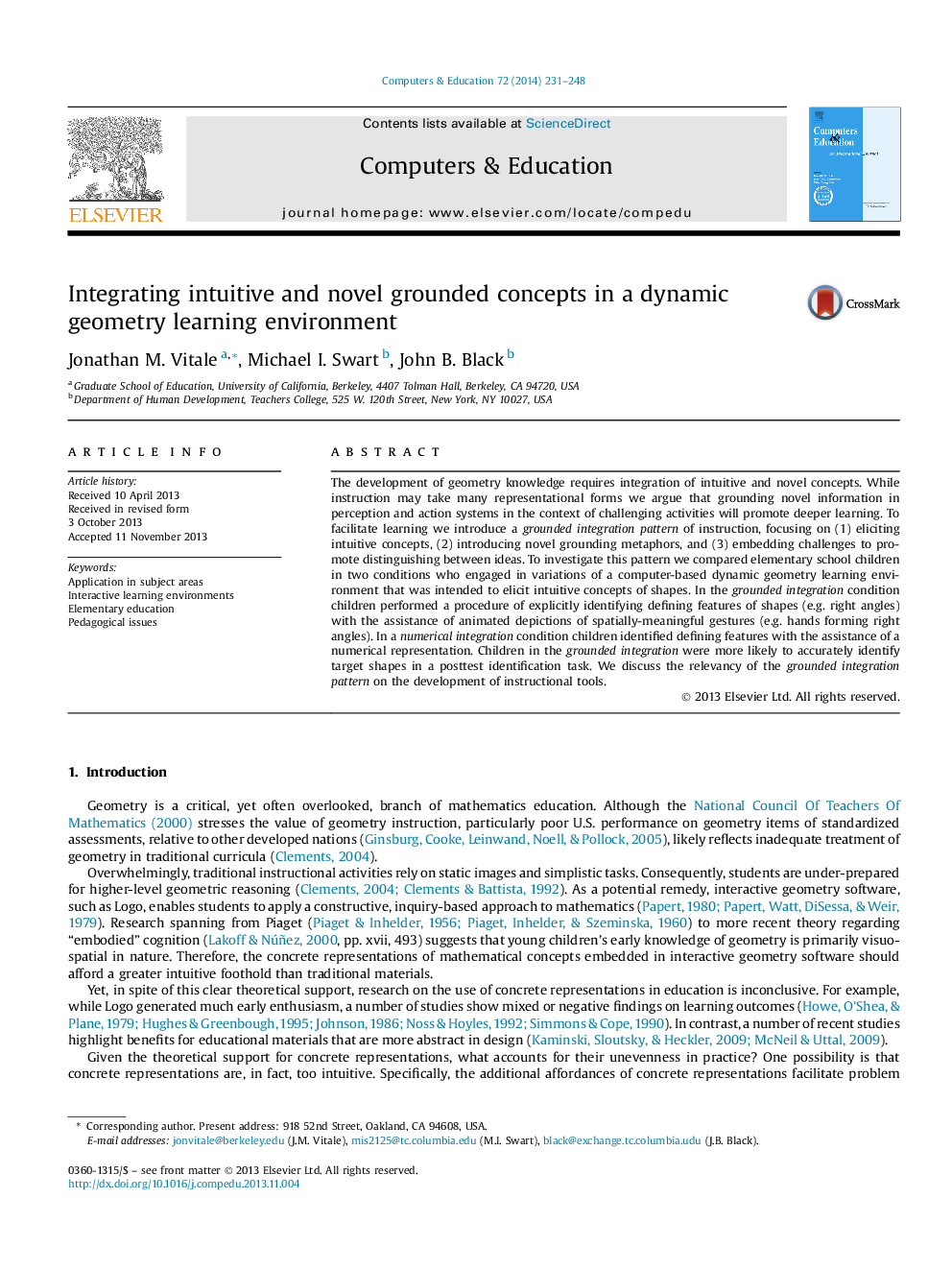| کد مقاله | کد نشریه | سال انتشار | مقاله انگلیسی | نسخه تمام متن |
|---|---|---|---|---|
| 6835293 | 618187 | 2014 | 18 صفحه PDF | دانلود رایگان |
عنوان انگلیسی مقاله ISI
Integrating intuitive and novel grounded concepts in a dynamic geometry learning environment
ترجمه فارسی عنوان
ادغام مفاهیم شهودی و ریشه ای در محیط یادگیری پویایی هندسه
دانلود مقاله + سفارش ترجمه
دانلود مقاله ISI انگلیسی
رایگان برای ایرانیان
کلمات کلیدی
کاربرد در حوزه های موضوعی، محیط یادگیری تعاملی، تحصیلات ابتدایی، مسائل آموزشی
ترجمه چکیده
توسعه دانش هندسی نیازمند ادغام مفاهیم شهودی و رمان است. در حالی که آموزش ممکن است بسیاری از اشکال بازنمایی را بیابد، ما استدلال می کنیم که اطلاعات جدید ریشه در سیستم های ادراک و عمل در چارچوب فعالیت های چالش انگیز، آموزش های عمیق تر را ترویج می دهند. برای تسهیل یادگیری، یک الگوی ادغام مبتنی بر آموزش را معرفی می کنیم، با تمرکز بر (1) تشریح مفاهیم شهودی، (2) معرفی استعاره های پایه ای جدید، و (3) چالش های تعبیر برای ترویج تفکیک بین ایده ها. برای بررسی این الگو، کودکان دو دانش آموز ابتدایی را در دو حالت مقایسه کردیم که شامل تغییراتی در یک محیط یادگیری هندسی مبتنی بر رایانه بود که هدف از آن ارائه مفاهیم بصری از اشکال بود. در شرایط یکپارچگی پایه، کودکان با روش تصویرسازی متحرک حرکات معنایی مکانی (مثلا دست راست زاویه ای)، روش مشخصی از مشخصه های مشخص شکل (مانند زوایای راست) را شناسایی کردند. در شرایط یکپارچگی عددی، کودکان با شناسایی عددی تعریف ویژگی ها را مشخص می کنند. کودکان در یکپارچگی پایه بیشتر احتمال دارد که با دقت شناسایی اشکال هدف را در یک کار شناسایی پس از آزمایش مشخص کنند. ما در مورد تناسب الگوی ادغام مبتنی بر توسعه ابزارهای آموزشی بحث می کنیم.
موضوعات مرتبط
علوم انسانی و اجتماعی
علوم اجتماعی
آموزش
چکیده انگلیسی
The development of geometry knowledge requires integration of intuitive and novel concepts. While instruction may take many representational forms we argue that grounding novel information in perception and action systems in the context of challenging activities will promote deeper learning. To facilitate learning we introduce a grounded integration pattern of instruction, focusing on (1) eliciting intuitive concepts, (2) introducing novel grounding metaphors, and (3) embedding challenges to promote distinguishing between ideas. To investigate this pattern we compared elementary school children in two conditions who engaged in variations of a computer-based dynamic geometry learning environment that was intended to elicit intuitive concepts of shapes. In the grounded integration condition children performed a procedure of explicitly identifying defining features of shapes (e.g. right angles) with the assistance of animated depictions of spatially-meaningful gestures (e.g. hands forming right angles). In a numerical integration condition children identified defining features with the assistance of a numerical representation. Children in the grounded integration were more likely to accurately identify target shapes in a posttest identification task. We discuss the relevancy of the grounded integration pattern on the development of instructional tools.
ناشر
Database: Elsevier - ScienceDirect (ساینس دایرکت)
Journal: Computers & Education - Volume 72, March 2014, Pages 231-248
Journal: Computers & Education - Volume 72, March 2014, Pages 231-248
نویسندگان
Jonathan M. Vitale, Michael I. Swart, John B. Black,
